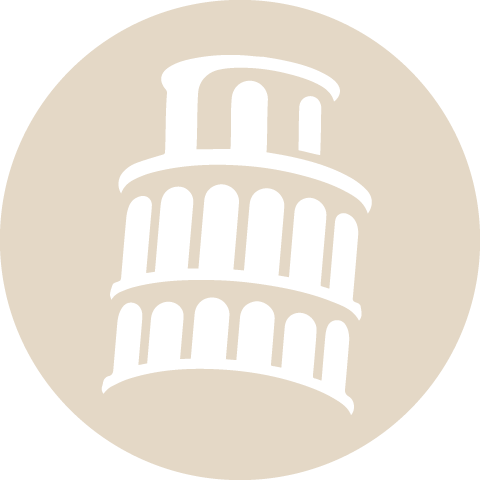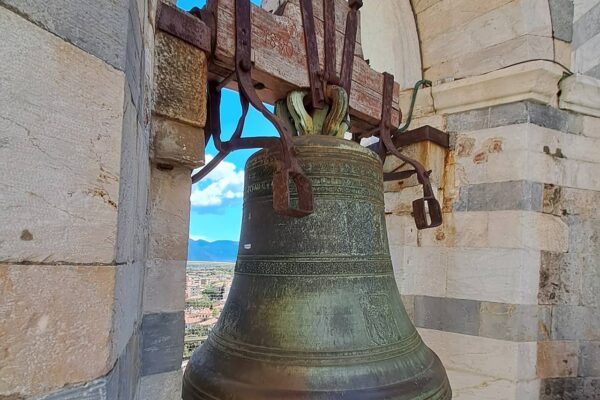If you are passionate about Tuscany and its wonders,want to visit the Baptistery of Pisa and want more information about what to see, when to visit it, and how to access it, you are in the right place.
In this article, I will take you through a virtual journey to discover the Baptistery, one of the gems of the Piazza dei Miracoli.
I will provide you with essential information on how to get to this architectural wonder, tips on how to buy tickets to skip the line, and suggestions on when is the best time to visit.
We will explore together the fascinating history of the Baptistery and its extraordinary architecture. I will delight you with intriguing trivia related to this iconic structure and take you inside to admire its magnificent details.
In addition, we will examine the artistic importance of the Baptistery, focusing on the majestic Porta Maggiore and its reliefs, as well as the sumptuous baptismal font with its elegant inlays.
Finally, we will immerse ourselves in the extraordinary work of Nicola Pisano, the pulpit of the Baptistery, a masterpiece of thirteenth-century sculpture that continues to enchant visitors with its timeless beauty.
Are you ready? Then, have a seat and get ready to explore the magnificent Pisa Baptistery!
Wait. Before you start reading the article, a brief warning: you should know that the Baptistery of Pisa is the largest in the world, given its celebrity to visit it you will risk running into a long line at the ticket office. To get inside the attraction by skipping the line at the entrance, it is always recommended to purchase a ticket online. Click below to book your admission and get inside the Baptistery of Pisa in an instant.
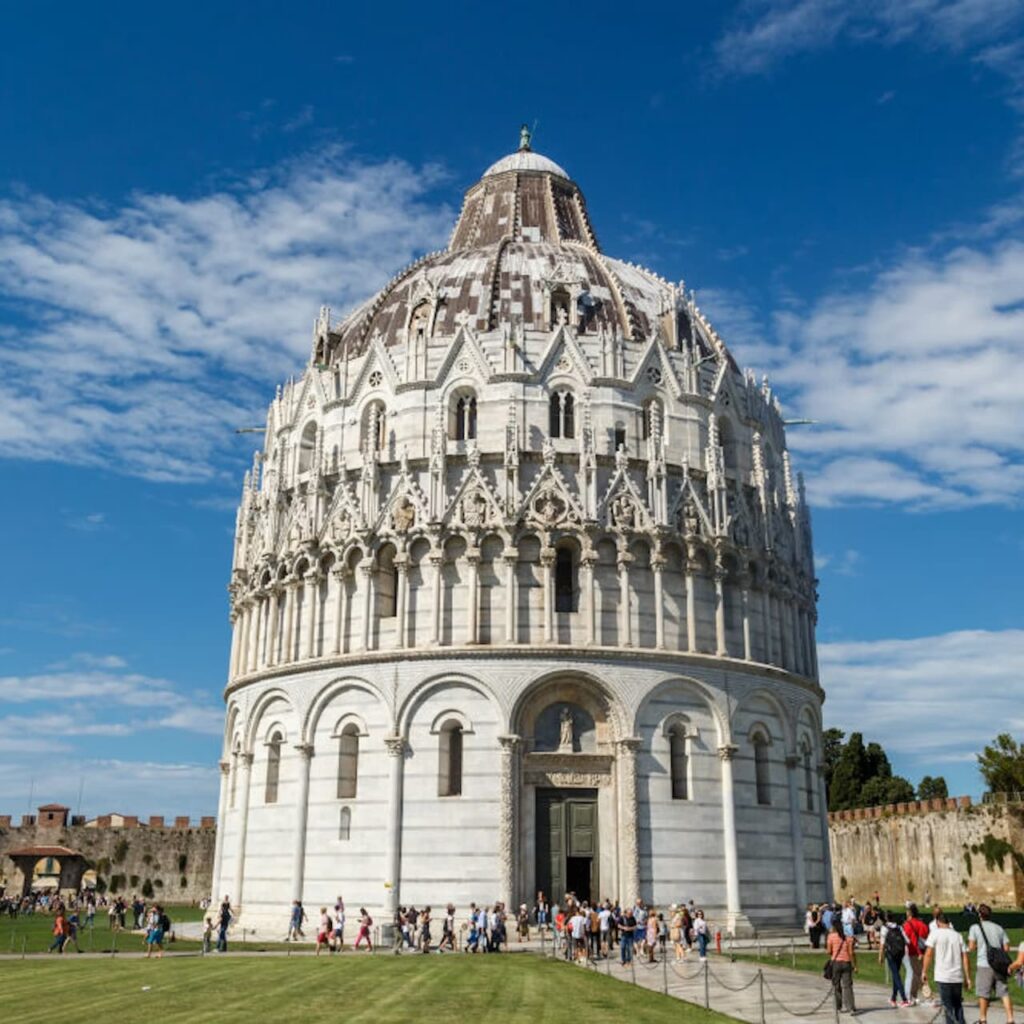
Baptistery, Cemetery, Cathedral + The Leaning Tower of Pisa: Admission
Purchase online. Choose the time of your choice. Visit Piazza dei Miracoli and its attractions: the Baptistery, the Camposanto, the Cathedral and the famous Tower of Pisa.
You can cancel for free up to the day before the visit.
Baptistery of Pisa description
Table of content
- 1 Baptistery of Pisa description
- 2 Visit to the Baptistery of Pisa: what to see
- 3 The history of the Baptistery of Pisa
- 4 Baptistery of Pisa: curiosities
- 5 Useful information: schedules, prices, how to get there
- 6 Nearby attractions
- 7 Baptistery Pisa tickets
- 8 Baptistery of San Giovanni Pisa: frequently asked questions
- 9 Battistero Piazza dei Miracoli Pisa: conclusions
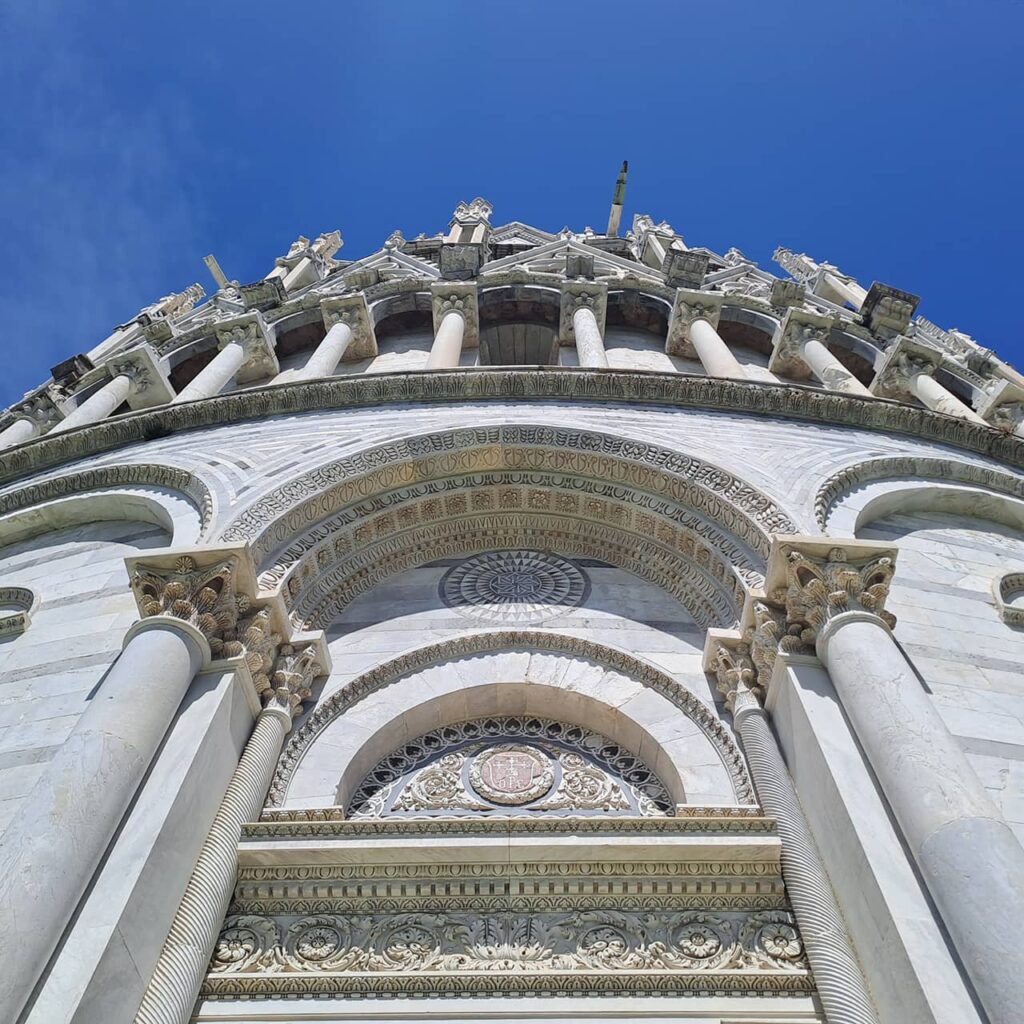
Positioned majestically in Piazza del Duomo, also known as Piazza dei Miracoli, the Baptistery of Pisa stands out as one of the city’s most impressive and significant attractions.
The name “Square of Miracles” seems to derive from acclaimed writer Gabriele D’Annunzio, who in 1910 mentioned the square in his novel Forse che sì forse che no (Maybe Yes, Maybe No), describing the imposing monuments as “Miracles.”
Prominent among these monuments is the majestic Baptistery.
The Baptistery of St. John the Baptist stands opposite the Cathedral, creating a striking architectural counterpoint.
The architecture of the Baptistery represents a sublime fusion of styles, combining Romanesque and Gothic elements with harmony and grandeur.
With a circumference of 107.24 meters and a height of 54.66 meters, the Baptistery of Pisa is the largest of its kind in the world, a tangible testament to the artistic and engineering greatness of the time.
The main access to the building is through the East Portal, one of four portals that open at the cardinal points.
The Major Portal, embellished with reliefs narrating the months of the year, apostolic figures, and events related to the life of St. John the Baptist, enchants visitors with its majesty and refined sculptural beauty.
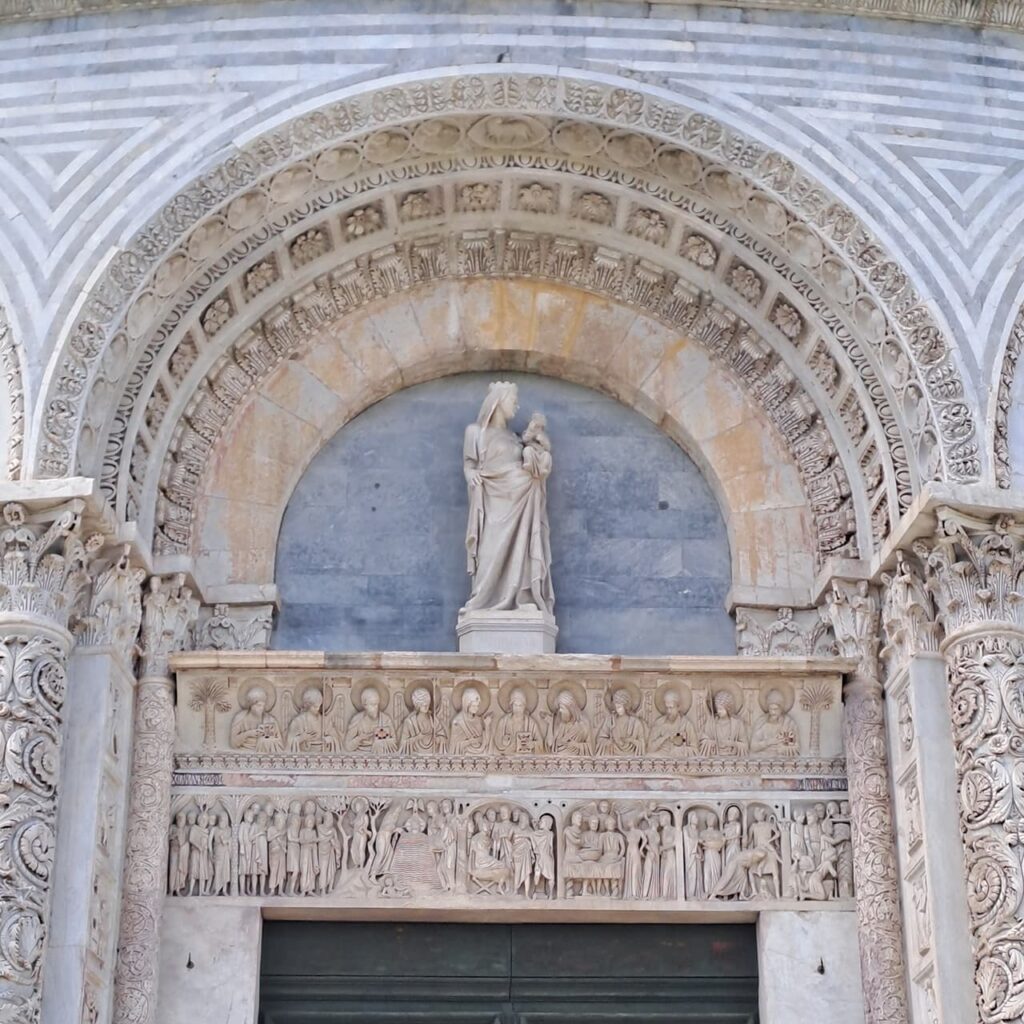
Visit to the Baptistery of Pisa: what to see
Interior of the Baptistery

The interior of the Baptistery opens with a vast central area, with an echoing atmosphere, bordered by a ring formed by eight columns and four pillars, topped by a matroneum.
The appearance is austere, characterized by the black and white marble decorations on the floor, which converge toward the baptismal font.
Surrounding the latter, which is also famous for being the baptismal site of Galileo Galilei, are columns and pillars, connected by rounding arches.
The baptismal font, octagonal in shape and made of inlaid marble, bears the inscription of Guido Bigarelli da Como, the sculptor who created it.
It hosts four smaller, shallower basins for the baptism of infants, while adults were immersed in the deeper central basin.
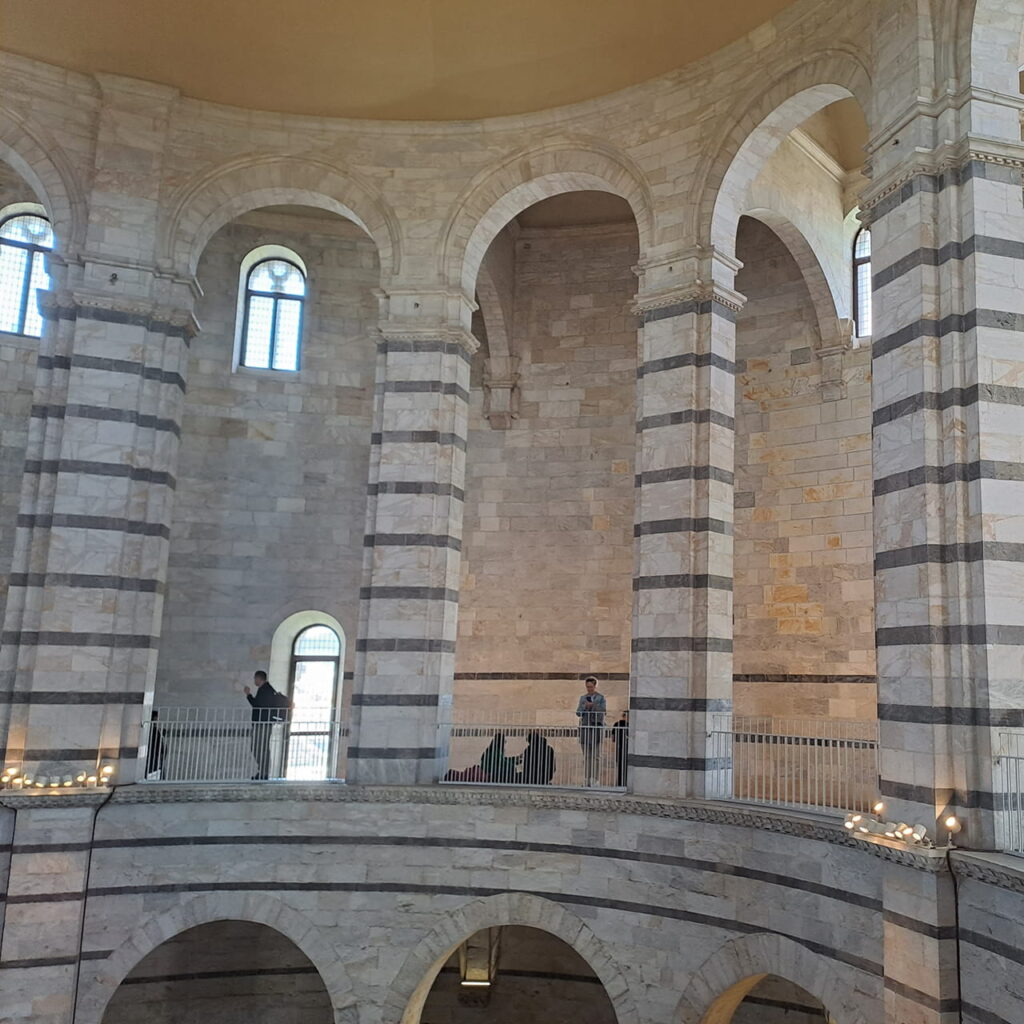
At the back of the font stands the altar, and the floor, composed of a sequence of polychrome marbles, has a peculiar arrangement of light marble slabs interspersed with strips of black marble, creating a kind of spider’s web that guides the eye to the center, toward the baptismal font.
The Matron’s Hall, with its colonnade punctuated by black and white marble, adds an element of elegance to the environment.
Finally, the interior dome, essential and simple in its decoration, completes the atmosphere of solemnity and grandeur of the Baptistery.
Dome and exterior roof of the Baptistery
The dome of the Baptistery internally is truncated cone-shaped, while externally it takes the form of a hemispherical dome. This conformation allows the building to have excellent acoustics.
On the hemispherical dome is located the bronze of St. John the Baptist. The dome, with a dodecagonal base, closes the building.
The dome is covered with red tiles and lead slabs toward the east. This curious two-tone composition is probably due to an absence of funds.
Although originally planned, the dome has no frescoes. Its simplicity gives the environment a magical atmosphere that recalls the presence of the Spirit.
Performing the dome were Puccio di Landuccio and Cellino di Nese.

Baptistery, Cemetery, Cathedral + The Leaning Tower of Pisa: Admission
Purchase online. Choose the time of your choice. Visit Piazza dei Miracoli and its attractions: the Baptistery, the Camposanto, the Cathedral and the famous Tower of Pisa.
You can cancel for free up to the day before the visit.
The history of the Baptistery of Pisa

In the aftermath of the Crusades, the maritime republic of Pisa found itself with substantial spoils. Further wealth came to Pisa from the Expedition to Sicily against the Ottomans.
It was thus decided to build Piazza Dei Miracoli, a place representing the greatness of the city of Pisa at the height of its economic and military expansion.
The circular building, inspired by the Holy Sepulcher in Jerusalem, was begun in 1153 by architect Diotisalvi, who directed the work until 1180.
To the work of Diotisalvi are attributed the interior wall partition of the pentagonal pillars, while on the exterior the series of archways of the first order and the long ornate gallery of arches and columns that makes up the second order.
After 1180, work began to slow down and then stopped altogether.
Although not yet completed at this time,the Baptistery was already in use and religious events and ceremonies were held inside.
Work resumed during the 13th century, the interior decoration of the building was entrusted first to Guidi and later to Brigarelli.
Shortly after the middle of the thirteenth century, Nicola Pisano completed the outer median loggia with the distinctive Gothic-style decoration depicting monumental heads and busts of Saints and Prophets.
Alongside Nicola Pisano, his son Giovanni also worked between 1278 and 1284.
The original plan was to decorate the interior of the building with a rich array of frescoes, but due to a lack of funds from the Opera di San Giovanni, which had already produced obstacles and slowed the completion of the building, the project was never completed.
During the nineteenth century, the Baptistery underwent major renovations along with the adjacent buildings in Piazza Dei Miracoli.
During restorations between 1850 and 1856, a competition was announced to fresco the dome, but the work, however, was never executed.
Baptistery of Pisa: curiosities
- Magnificent dimensions: The Baptistery of Pisa is the largest baptistery in the world. Its circumference extends 107.24 meters, the width of the masonry at the base measures 263 cm, and the height reaches 54.86 meters.
- Troncoconic dome: The dome of the Baptistery has a truncated cone shape. This architectural style is similar to that of the Church of the Holy Sepulcher in Pisa, also designed by the same architect, Diotisalvi. The dome is reminiscent of the Holy Sepulcher in Jerusalem.
Useful information: schedules, prices, how to get there
This is the “practical” section where we discuss how to get there, where to park, and how to visit the Baptistery.
Where it is located and how to get to the Baptistery of Pisa
The Baptistery of Pisa is located in the famous Square of Miracles in the eponymous city of Pisa.
GPS coordinates are 43° 43′ 23.77″ N, 10° 23′ 39.12″ E.
By train
If you arrive by train, as you exit the station you will find yourself in Station Square. From here:
- Proceed straight through a traffic circle and Vittorio Emanuele Square until you reach Corso Italia.
- Continue along Corso Italia to the Arno River. Cross the Ponte Vecchio and, on your right, you will find Piazza Garibaldi. Walk along it to an intersection and turn left into Borgo Stretto.
- You will find Via Ulisse Dini on your left: take it and you will arrive in Piazza Dei Cavalieri, where the historic headquarters of the Normale di Pisa is located. In the same square stands the tower that tells the tragic story of Count Ugolino and his sons, narrated by Dante in the Divine Comedy.
- Continue on Via Corsica to Piazza Francesco Buonamici and continue on Via Dei mille to Piazza Felice Cavallotti.
- From here, take Via Santa Maria, where you will find numerous restaurants and tourist spots.
- On your right, walk down Via Santa Maria until you reach Piazza Dei Miracoli, where the Baptistery of Pisa is located.
By car
If you plan to arrive in Pisa by car, you can take the highway exit Pisa Centro, and then follow the signs to Piazza dei Miracoli. Below is a list of parking lots (free and not) where you can leave your car for the duration of your stay.
- Via Pietrasantina (free parking): Located outside the city walls, near Pisa Stadium. Shuttle available to Miracles Square-about 1km from Miracles Square.
- Via Paparelli (free parking): Outside the city walls. Free except on Wednesdays and Saturdays (market days)-about 1km from Piazza dei Miracoli.
- Via Pratale (free parking): North of Pisa, near the stadium. Free parking with possibility to reach the Tower by bus or on foot-about 3km from Piazza dei Miracoli.
- Cameo Street (paid parking): Behind the Leaning Tower. Daytime rate: 2€/hour, nighttime: 1€/hour-about 150 meters from Piazza dei Miracoli.
- Via Vecchia Barbaricina (paid parking): Next to the previous parking lot. Single fee: 1.50€/hour-about 150 meters from Piazza dei Miracoli.
- Piazza Vittorio Emanuele (paid parking): Near Pisa Central Station, about 2km from the Tower. Rate: 2€/hour-about 2km from Piazza dei Miracoli.
For more information, read the article on how to get to the Square of Miracles.
Baptistery Hours
The Baptistery is open daily, Monday through Sunday, from 9 a.m. to 8 p.m.. The last entry to the monuments is allowed until 30 minutes before closing.
Piazza Dei Miracoli is a public square and therefore remains always open to the public even if the monuments are closed.
Where to eat near the Baptistery of Pisa
The Caffè dell’Opera del Duomo in Pisa is a charming place located right in Piazza Dei Miracoli, just a few steps from the Baptistery and the celebrated Leaning Tower.
Why come here for your lunch break while visiting the monuments of Pisa?
The view is simply breathtaking: The Opera Cafe offers a unique panoramic view of the Tower of Pisa. Imagine enjoying a coffee or snack while admiring this iconic monument so close you feel like you can touch it.
The setting is elegant and refined, with traditional furnishings and details that recall the history and art of Pisa.
It is the ideal place with an exclusive view for a break during your visit to the Piazza dei Miracoli. Although the menu is not extremely varied, the Opera Cafe offers high quality dishes.
The prices may be slightly higher, but the overview makes the experience unforgettable.
Where to sleep near the Baptistery of Pisa
If you would like to stay near the Pisa Baptistery and enjoy a breathtaking view of the Piazza dei Miracoli, you can consider a few options.
- Residenza d’Epoca Relais I Miracoli: just 70 meters from the Leaning Tower, offers a historic atmosphere and elegant rooms;
- Hotel Pisa Tower: located about 150 meters from the Tower of Pisa, boasts air-conditioned rooms with views of the tower itself;
- Grand Hotel Duomo Pisa: just a 2-minute walk from the Piazza del Duomo and Leaning Tower, offers a rooftop bar and rooftop terrace with views of the city.
All of these options are located right in the Piazza dei Miracoli area and provide convenient access to Pisa’s main attractions.
Nearby attractions
Piazza Dei Miracoli is home to the most important monuments of the Tuscan city, such as the famous Torre di Pisa, one of the most visited attractions in Italy, whose dependence is due to the instability of the ground on which it was built.
Another important building to visit near the Baptistery is the Duomo di Pisa. Like the Baptistery, the Duomo has numerous influences and is the work of multiple masters. Its many Eastern influences are evidence of Pisa’s centrality within trade and cultural exchanges.
In Piazza dei Miracoli you will also find the famous Museo delle Sinopie, which preserves the sinopites of the Camposanto frescoes, saved and restored after World War II.
At the Museo dell’Opera del Duomo, on the other hand, you will discover the history of the workers who helped build the Cathedral, along with a collection of sacred vestments, wood inlays, and a rich collection of statuary.
Finally, next to the Baptistery, the Camposanto hosts frescoes of great beauty and ancient Roman sarcophagi, along with the tombs of illustrious figures from Pisa’s political, cultural, and religious history.
Baptistery Pisa tickets
Tickets to visit the attractions in Piazza dei Miracoli (your choice of: Baptistery, Camposanto, Museo dell’opera del Duomo, Museo delle Sinopie) are priced as follows:
- from €15 for access to all monuments(excluding the Tower)
- from €33 for access to all Piazza dei Miracoli attractions (including the Leaning Tower of Pisa)
If you would like to participate in a guided tour instead, see all ticket options for attractions in Pisa’s Piazza dei Miracoli here.

Baptistery, Cemetery, Cathedral + The Leaning Tower of Pisa: Admission
Purchase online. Choose the time of your choice. Visit Piazza dei Miracoli and its attractions: the Baptistery, the Camposanto, the Cathedral and the famous Tower of Pisa.
You can cancel for free up to the day before the visit.
Baptistery of San Giovanni Pisa: frequently asked questions
The interior of the Baptistery is very simple and unadorned, but it offers exceptional acoustics. Inside you can find the octagonal baptismal font made by Guido Bigarelli of Como.
The Baptistery is famous because inside it was baptized Galileo Galilei.
As for tickets, here are the options: the starting price to visit the Baptistery is €15.00. Prices vary widely depending on whether there is a guided tour or not. The purchase of any ticket also includes admission to the Cathedral, which is always free. Click here to find out all available tickets for Piazza dei Miracoli, in Pisa.
The Baptistery of Pisa is the largest baptistery in the world.
Because the octagonal shape is symbolic of the resurrection. In fact, St. Ambrose records that Christ resurrected eight days after entering Jerusalem.
Battistero Piazza dei Miracoli Pisa: conclusions
We have come to the end of this post on the wonderfulBaptistery of Pisa, one of the most famous attractions in Piazza Dei Miracoli.
We looked together at its history and curiosities that make it even more interesting to visit, restaurants to eat at, and hotels to stay at during your experience in Pisa.
We found outhow to get there, where to park, and how to buy tickets online.
If you need more information, please leave a comment below; however, if you would like to visit the Baptistery, the Camposanto, or other attractions in the Piazza dei Miracoli, purchase your entrance ticket by skipping the ticket office line.
